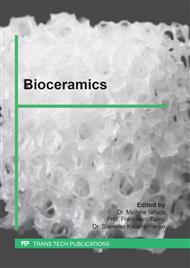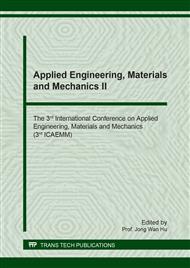p.328
p.333
p.338
p.344
p.349
p.354
p.360
p.367
p.373
Surface Characteristics of Dentin Derived Hydroxyapatite Coated Layer on Titanium by RF Magnetron Sputtering
Abstract:
The aim of this study was to evaluate surface characteristics and biological properties of the dentin derived hydroxyapatite (DDHA) coating on titanium substrate. DDHA was derived from extracted human teeth with calcination method at 850°C. The commercially pure titanium was used as a metallic substrate and a RF magnetron sputtering method was used as a coating method. Scanning Electron Microscopy (SEM) and Energy Dispersive X-ray analysis (EDX) were performed to investigate the morphology and composition of coating surface. Atomic Forced Microscopy (AFM) and surface profiler were used to assess the surface morphology and roughness. Corrosion tests were performed in phosphate buffered saline at a 36.5±1°C in order to determine the corrosion behavior of the uncoated and coated surface samples. The biocompatibility of DDHA coating surface samples with murine osteoblastic cells was assessed by SEM. As a results, thin coating layer was observed on SEM images and uniformly cover the surfaces without change of titanium substrate. The EDX analysis of this coating surface indicated the presence of Ca, P elements. The mean surface roughness of cp-Ti and DDHA coating samples was 0.27μm, 1.7μm, respectively. The corrosion test indicated the stable passive film on coating samples. SEM observations of murine osteoblastic cells on coating surface showed that cells have proliferated and developed a network of dense interconnections. These results suggest that DDHA coating with RF magnetron sputtering method has good surface characteristics and biocompatibility.
Info:
Periodical:
Pages:
349-353
Citation:
Online since:
July 2018
Authors:
Price:
Сopyright:
© 2018 Trans Tech Publications Ltd. All Rights Reserved
Share:
Citation:



